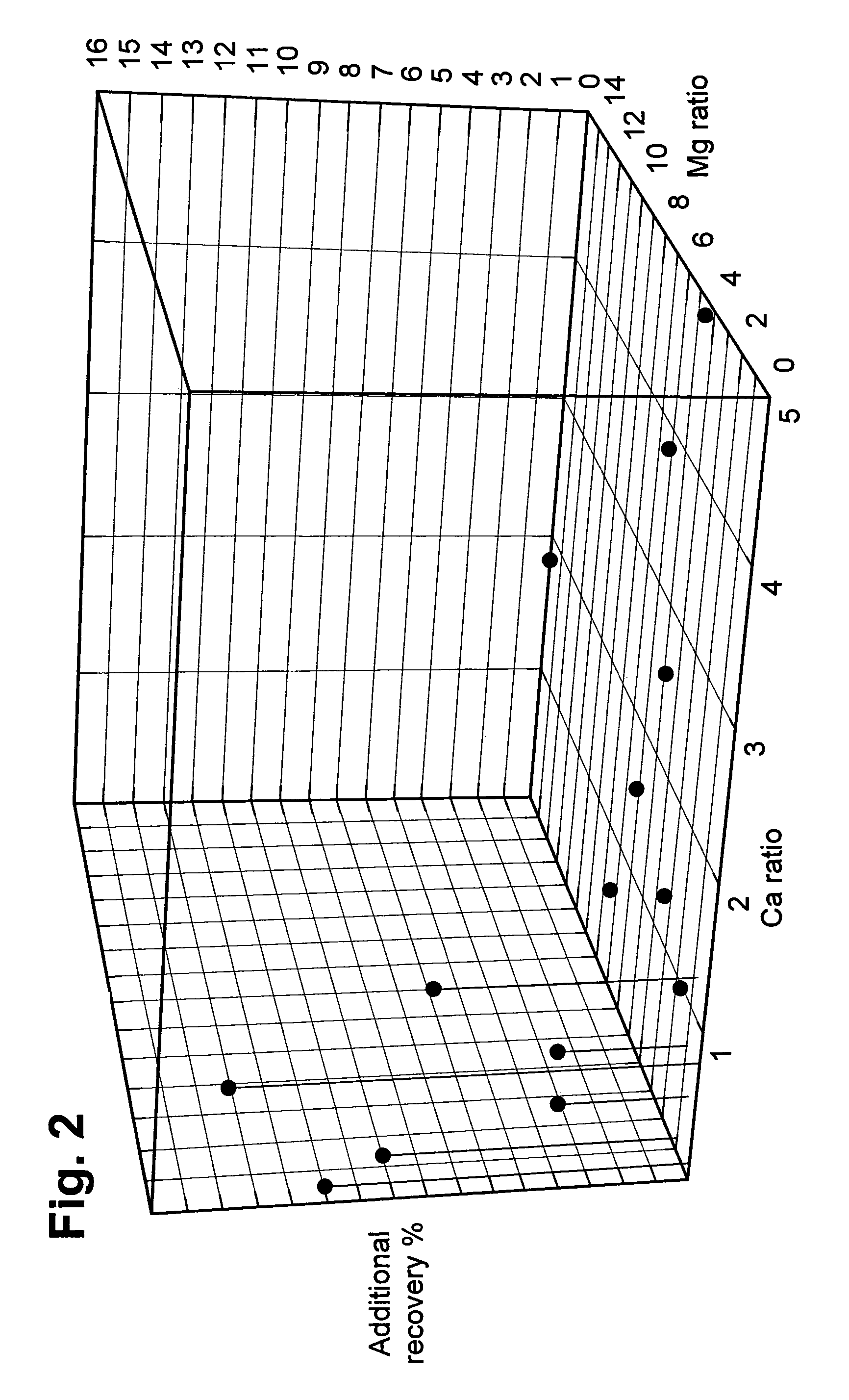Hydrocarbon recovery process
a technology of hydrocarbon recovery and water treatment, applied in the direction of fluid removal, survey, borehole/well accessories, etc., can solve the problem that low salinity waters are often not available at a well site, and achieve enhanced oil recovery, low salinity, and better oil recovery
- Summary
- Abstract
- Description
- Claims
- Application Information
AI Technical Summary
Benefits of technology
Problems solved by technology
Method used
Image
Examples
example 8
[0062]The SWCTT tests of Examples 1-7 were repeated with a number of different sized slugs of the aqueous displacement fluid (injection water) of analysis Ca 1.47 ppm / Mg 0 ppm / Divalent TDS 10 ppm. The connate water contained Ca 320 ppm / Mg 48 ppm / Divalents 398 ppm / TDS 31705 ppm giving the divalent fraction of 0.003. The oil had an API gravity of 23°. The formation contained 13.8% kaolinite.
[0063]Produced water, which was the connate water in the test, was passed into the formation first, giving an Sor of 0.42. A slug of 0.2 PV of the injection water was then passed giving an Sor of 0.42 followed by a repeat slug of the produced water. A slug of 0.4 PV of the injection water was then passed giving an Sor of 0.27, followed again by a slug of the produced water. The Sor was at 0.27 after a slug of 0.7 PV of the injection water was passed again followed by produced water. The Pore Volume, PV, was determined from modelling studies.
example 9
[0064]The SWCTT tests of Ex 8 were repeated with a number of different sized slugs of the aqueous displacement fluid (injection water) of analysis Ca 30 ppm / Mg 6 ppm / Divalent 37 ppm TDS. The connate water was the same as in Ex 8 giving the divalent fraction of 0.09. The oil had an API gravity of 23°. The formation contained 12.2% kaolinite.
[0065]Produced water, which was the connate water in the test, was passed into the formation first, giving an Sor of 0.41. A slug of 0.2 PV of the injection water was then passed giving an Sor of 0.37, followed by a repeat slug of the produced water. A slug of 0.3 PV of the injection water was then passed giving an Sor of 0.30, followed again by a slug of the produced water. The Pore Volume, PV, was determined by modelling studies.
example 10
[0066]The following studies utilized a coreflood facility which operates at reservoir conditions, of up to 150° C. and 10,000 psi. The equipment of the coreflood facility has an in-situ saturation monitor (described below) and uses live fluids (reservoir fluids that are equilibrated with reservoir gas) both for ageing and fluid flow. Volumetric production is measured at the reservoir conditions using an in-line separator. Saturations during and at the end of the flood are assured by measuring the amount of the pore space occupied by radioactively doped brine. The in-situ saturation monitor not only determines the saturation but also provides a quantitative analysis of the integrity of the slug, due to the difference in capture cross section between high salinity radioactively-doped brines and low salinity brines.
Core Preparation
[0067]Core plug samples, nominally 3″ long by 1½″ in diameter were used for this study. The samples were first restored i.e. the samples were cleaned using m...
PUM
| Property | Measurement | Unit |
|---|---|---|
| pressure | aaaaa | aaaaa |
| temperature | aaaaa | aaaaa |
| temperature | aaaaa | aaaaa |
Abstract
Description
Claims
Application Information
 Login to View More
Login to View More - R&D
- Intellectual Property
- Life Sciences
- Materials
- Tech Scout
- Unparalleled Data Quality
- Higher Quality Content
- 60% Fewer Hallucinations
Browse by: Latest US Patents, China's latest patents, Technical Efficacy Thesaurus, Application Domain, Technology Topic, Popular Technical Reports.
© 2025 PatSnap. All rights reserved.Legal|Privacy policy|Modern Slavery Act Transparency Statement|Sitemap|About US| Contact US: help@patsnap.com



